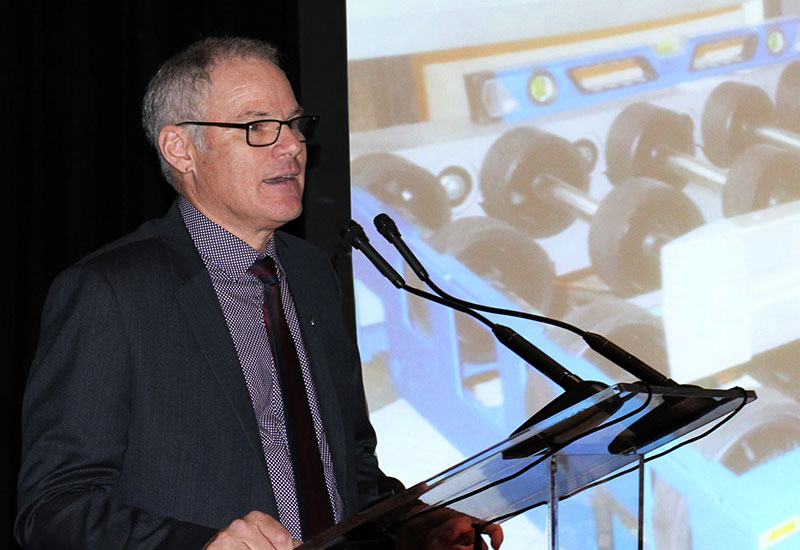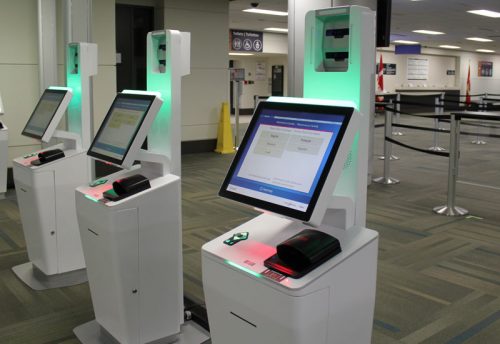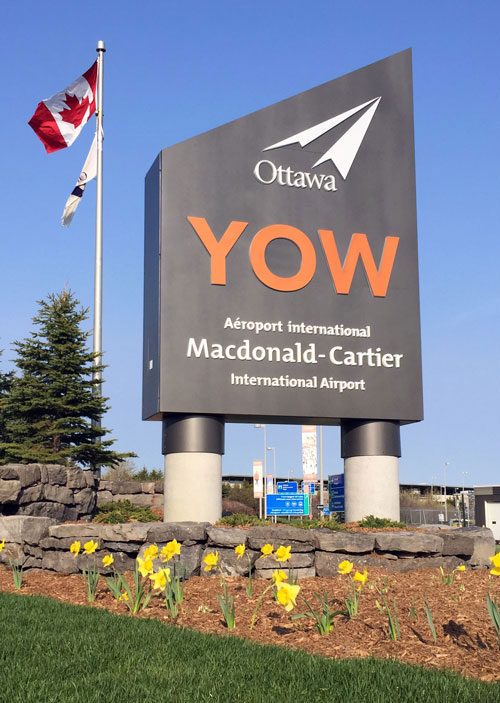2016 in Review
OPTIMIZE OPERATIONAL PERFORMANCE, ENSURING SAFE AND SECURE AIRPORT OPERATIONS
OPERATIONS
The project list for 2016 was as long as it was complex and required the collaboration of not only the Authority’s various teams but also our campus partners whose help was invaluable. Here are a few of the projects that we focused on:

Airport Authority President and CEO, Mark Laroche
Baggage Handling System
The Authority completed one of the most complex projects it has undertaken since the construction of the terminal building. The $60.0 million baggage handling system (BHS) upgrade project was fully commissioned in the summer, after an intensive 33-month construction schedule that included tenant moves and new building construction to accommodate them. A new maintenance building, water fill building, and new tug charging building were constructed, along with new space fit-ups for Air Canada and the Canadian Air Transport Security Authority (CATSA), before work on the BHS could begin.
In addition to capacity and aging technology issues, changing regulatory requirements in airport security necessitated the upgrade. The new system includes features such as the U.S. Baggage Weight Induction System, or BIWIS, which weighs and scans bags, among other important features required by U.S. Customs and Border Protection (U.S. CBP). It also accommodates new CATSA screening requirements.
Overarching all of the technical requirements, the Authority was keen to ensure that the new system would facilitate more efficient baggage delivery for our airline and ground handling partners, and ultimately provide better service to our customers. Two aspects of the project highlight the enhancements most prominently: first, for passengers connecting from domestic to transborder (U.S.), bags are seamlessly transferred without the need to reclaim and recheck; and second, arriving domestic passengers now have an additional carousel from which to retrieve their checked luggage. From a capacity perspective, the new system will process 2,000 domestic bags per hour and 1,000 transborder bags, which doubles the old system. From an energy perspective, while the system is physically more than double the size than the old system, it uses less power, which is great for the environment and our community.
Perhaps the most remarkable aspect of the project was that the entire new system was installed in the equivalent of a crawlspace over the existing system, was tested while the existing system was operational, and it was all completed with no system downtime.
If you asked our passengers if they were aware of this massive project, most would have said no. That is a testament to the effort of every organization and individual that played a role in the project and appreciated the unique requirements of a working airport.
The Authority invited every company that worked on the project, including Beumer Group, the company that supplied the BHS, and CATSA, who contributed $25.0 million to the cost of the project, to a celebration to mark its official completion in the arrivals hall by the new carousel.
BHS Project Fun Facts
- A total of 168,807 labour hours were logged;
- 41,000 security hours were logged;
- The electrical installation took 17,000 hours;
- 933,266 kilograms of steel were installed;
- 29,000 kilograms of conveyor and 24,000 kilograms of Crisbag were installed;
- More than 100 kilometres of cable were installed; and
- 175 new bollards were installed.
IT Facts
- 14 core BHS servers;
- 56 virtual core processor units;
- Over 5 terabytes of hard disk space and 200 gigabits of RAM used; and
- Between 7,000 and 8,000 sortation messages come in every day.
ACI Carbon Accreditation Level 1
Airports Council International North-America’s (ACI-NA) granted the Authority Level 1 of their four-level Airport Carbon Accreditation program on October 26th. The process for certification, which commenced in the spring, involved carbon footprint mapping for Authority-owned facilities and vehicles. Once completed, the calculations were verified by a third party, in keeping with program guidelines, and submitted for review. Achievement of this milestone sets the stage for the work required to reach Level 2 – greenhouse gas emission reduction. The program, which launched in Europe in 2009 and expanded to North America in 2014, independently assesses and recognizes airports’ efforts to manage and reduce their CO2 emissions. It certifies airports at four levels of accreditation including mapping, reduction, optimization, and neutrality.
Gate Upgrades
The Authority completed a multi-year project to upgrade several gates and replace the original passenger boarding bridges installed in 2003. All work to upgrade Gate 6 to accommodate larger aircraft was completed, and new bridges were installed on Gates 11, 12 and 16. As part of the upgrade of Gate 6 to accommodate larger aircraft, the existing smaller radial drive bridge was relocated from Gate 6 to Gate 2, providing bridged access for a gate that was previously ground-loading only.
Performance Based Navigation (PBN)
The United Nations-based Civil Aviation Organization (ICAO) introduced Performance Based Navigation (PBN) in 2015 as one of the essential tools required to improve global aviation safety and efficiency of future Communications, Navigation, Surveillance/Air Traffic Management (CNS/ATM) systems. Transport Canada is supportive of the ICAO’s PBN initiative and the need for globally harmonized operations that will improve the safety, efficiency, and environmental impact of aircraft operations.
Operations at YOW have traditionally been a mix of Required Navigation Performance (RNP – performance-based navigation that allows an aircraft to fly between two 3D-defined points in space included in PBN) and Required Navigational Approach Procedure (RNAV – a method of Instrument Flight Rules that allows an aircraft to choose any course within a network of navigation beacons) using ground navigational aids. In 2016, NAV CANADA presented a plan to increase the use of RNP through improved landing approaches that will be utilized by more aircraft operators. The plan was developed with input from the Authority and introduced to the community through a joint public consultation program. The PBN plan was approved for implementation in the fall of 2016.
 The effect of PBN is minimal at this time, as it is dependent on airlines to equip their aircraft with the necessary technology. Over time, however, the number of flights that use PBN will increase.
The effect of PBN is minimal at this time, as it is dependent on airlines to equip their aircraft with the necessary technology. Over time, however, the number of flights that use PBN will increase.
Primary Inspection Kiosks (PIK)
Canada Border Service Agency (CBSA) chose YOW as the inaugural airport to implement their new Primary Inspection Kiosk (PIK) technology in Q1 2017. Developed as a replacement for the Automated Border Control program, PIK will facilitate the Canada Customs process for all inbound passengers, regardless of their nationality or point of origin, via customer service kiosks. The Authority actively pursued inclusion in the project as a means of making the Customs process more efficient for our customers and optimizing the available space in the Canada Customs Hall to process more passengers. We are working closely with CBSA to ensure a smooth transition to the new program, including the addition of a team of customer service representatives who will aid our arriving passengers through the process.
Terminal Changes
 The Authority implemented many changes in and around the terminal that have made a big difference for our clients. We added more receivers to the airport’s free high-speed Wi-Fi network in various areas of the terminal where our passengers told us service was weak, to ensure that they can stay connected while travelling.
The Authority implemented many changes in and around the terminal that have made a big difference for our clients. We added more receivers to the airport’s free high-speed Wi-Fi network in various areas of the terminal where our passengers told us service was weak, to ensure that they can stay connected while travelling.
We made improvements to YOW’s wayfinding system to make navigating the terminal easier, and to increase the contrast on all terminal signage for greater accessibility.
We launched a plan to upgrade restrooms to exceed accessibility standards and to meet the needs of our aging population.
And perhaps the most notable change is on approach to the terminal, where we installed a new YOW airport sign at the point where the arrivals and departures roadways split. Designed and built in partnership with Pattison, our outdoor advertising partner, the sign provides a much more attractive welcome for our visitors.
SAFETY
The entire YOW team is committed to safety in all aspects of airport operations and we work with our campus partners to ensure a safe environment for all passengers and employees.
Winter Operations
Winter 2016 dropped significantly more snow on the ground than we typically see in Ottawa, with a total snowfall of 314 cm. On average, over the past 25 years, Ottawa has received 235 cm each winter. Most snow events that occurred measured less than 10 cm; however, one record-breaking storm on February 16th dumped 51.2 cm on the region. We are very pleased to report that the airport remained operational, and the majority of flights continued to operate despite the challenging conditions.
The end of the year proved to be much more challenging as well. In December alone, 99.8 cm of snow fell, in contrast to the 10-year average of 58.4 cm, and the 25.4 cm that fell in December 2015. The airside crew handled it like the seasoned professionals they are.”

Takeoff and Landing Performance Assessment (TALPA)
As discussed in 2015, ICAO has been working towards a TALPA methodology to standardize runway condition reporting globally, and set October 1st, 2016, as the date for full implementation in the U.S. With several carriers that serve YOW having adopted the new standards and the Federal Aviation Authority (FAA)-developed Runway Condition Assessment Matrix in 2015, the Authority had already taken the necessary steps to support the new standard. Despite record-breaking snowfalls in the region in 2016, the Authority met its TALPA targets and had a successful winter operation.
SECURITY
YOW continued to demonstrate aviation security leadership in 2016 in several areas, first among them being to exceed many of the standards set by Transport Canada within the Airport Security Program. YOW was a pilot airport for the Threat Risk Vulnerability Assessment requirement, in addition to introducing new industry-leading programs such as the Insider Threat Prevention training and an integrated Security Management System, to ensure the highest degree of security and safety for airport users. The airport also installed the first triple-layer anti-passback exit system, which achieves several goals: it enhances primary line security, prevents passengers from returning to the secure area, and reduces human resources costs which allows the Authority to reinvest in other security capabilities.
Other highlights in airport security that bear additional detail include the following:
No Drone Zone

Airport Authority President and CEO Mark Laroche
and Minister of Transport Marc Garneau
Early in the year, the Authority initiated a counter-drone project in the interest of commercial aircraft security. The first phase focused on awareness with a joint Airport Authority/Transport Canada/Ottawa Police Service media awareness campaign during which the Minister of Transport announced new drone regulations, possible legal implications for misuse, and branded “No Drone Zone” airport perimeter signage.
The Authority is investigating a drone detection system for deployment in 2017. The solution will be complemented with mitigation and response strategies.
Very Important Passengers
As Canada’s Capital, Ottawa’s airport is uniquely required to welcome a significant number of guests whose visits have unique security requirements. In 2016, we supported visits from the U.S. President, Vice President, and Secretary of State, the Presidents of Mexico and France, the Premier of China, numerous special Ambassadors for the One Young World Summit, and several thousand other diplomats and government VIPs. Each of these visits was handled flawlessly with excellent collaboration with all law enforcement and government agencies.
Top Dogs
The Authority’s Canine Unit continued to raise its level of excellence in 2016. It started the year sharing its skills and expertise with other law enforcement canine teams from across Canada in an extensive workshop at YOW. It finished the year with a win at the Canadian Law Enforcement Detection Dog Championships against 20 other police, corrections, and customs dog teams.
Non-passenger Screening Vehicles (NPS-Vehicles)
In 2014, we reported that the NPS-Vehicles program was to be fully implemented at Class 1 airports in Canada for all vehicles and occupants that access the critical restricted areas of the airfield. The Authority complied with two NPS-V checkpoints on the airfield. The program was broadened by Transport Canada in 2016 to include 100% document verification, which was implemented at YOW in April by placing contracted security personnel at both checkpoints to carry out inspections.The financial requirements for NPS-V capital facilities, non-CATSA security, and operating costs are borne entirely by airport authorities.
Exercise Dark Knight
The Authority hosted a comprehensive security and emergency response exercise in October based on multiple simulated terrorist attacks on the terminal. The event tested all levels of the airport’s emergency response plan and the Authority’s senior management team, but also the City of Ottawa’s Police, Paramedic and Fire services, U.S. Customs and Border Protection, Global Affairs Canada, and First Air as the airline partner.
In addition to our regular Airport Emergency Management training program that includes planning and training sessions, regular tabletop exercises and Red Team tests, exercises such as this serve to evaluate our capabilities and readiness in the context of global security events.
FINANCE
The Financial Year at a Glance
While the Canadian economy experienced mixed growth patterns in the first half of 2016, the second half growth trends were more encouraging and had a positive impact on the 2016 results for the airport. 2016 passenger volumes again broke previous years’ records, surpassing 4.7 million passengers, an increase of 1.9% over 2015. U.S. air carrier capacity continued to experience a decrease across most of Canada to their primary hubs, while domestic growth was strong as many transborder passengers were routed through Toronto and Montreal. Revenues in 2016 were 3.1% higher at $121.9 million compared to $118.3 million in 2015, mainly due to increased fees charged to airlines and higher passenger volumes which favourably impacted parking and ground transportation revenues. As a result, the Authority finished 2016 by generating earnings before depreciation of $22.8 million compared to $27.8 million in 2015 and a net loss after depreciation of $5.3 million compared to net earnings of $1.9 million in 2015. The Authority anticipated the year-over-year reduction in earnings due to the incremental interest impact from the Series E Bond issued in June 2015. As always, any earnings continue to be reinvested in airport operations and development in the interest of improving safety, efficiency, and the customer experience.
Five-year Review
| (in thousands of Canadian dollars) | 2012 | 2013 | 2014 | 2015 | 2016 |
|---|---|---|---|---|---|
| Revenues | $105,845 | $104,139 | $112,271 | $118,252 | $121,912 |
| Expenses before depreciation | 78,232 | 79,866 | 83,074 | 90,422 | 99,134 |
| Earnings before depreciation | 27,613 | 24,273 | 29,197 | 27,830 | 22,778 |
| Capital expenditures | 24,403 | 30,390 | 54,752 | 31,206 | 24,443 |
| AIF revenues | 39,379 | 38,370 | 43,629 | 45,434 | 46,920 |








